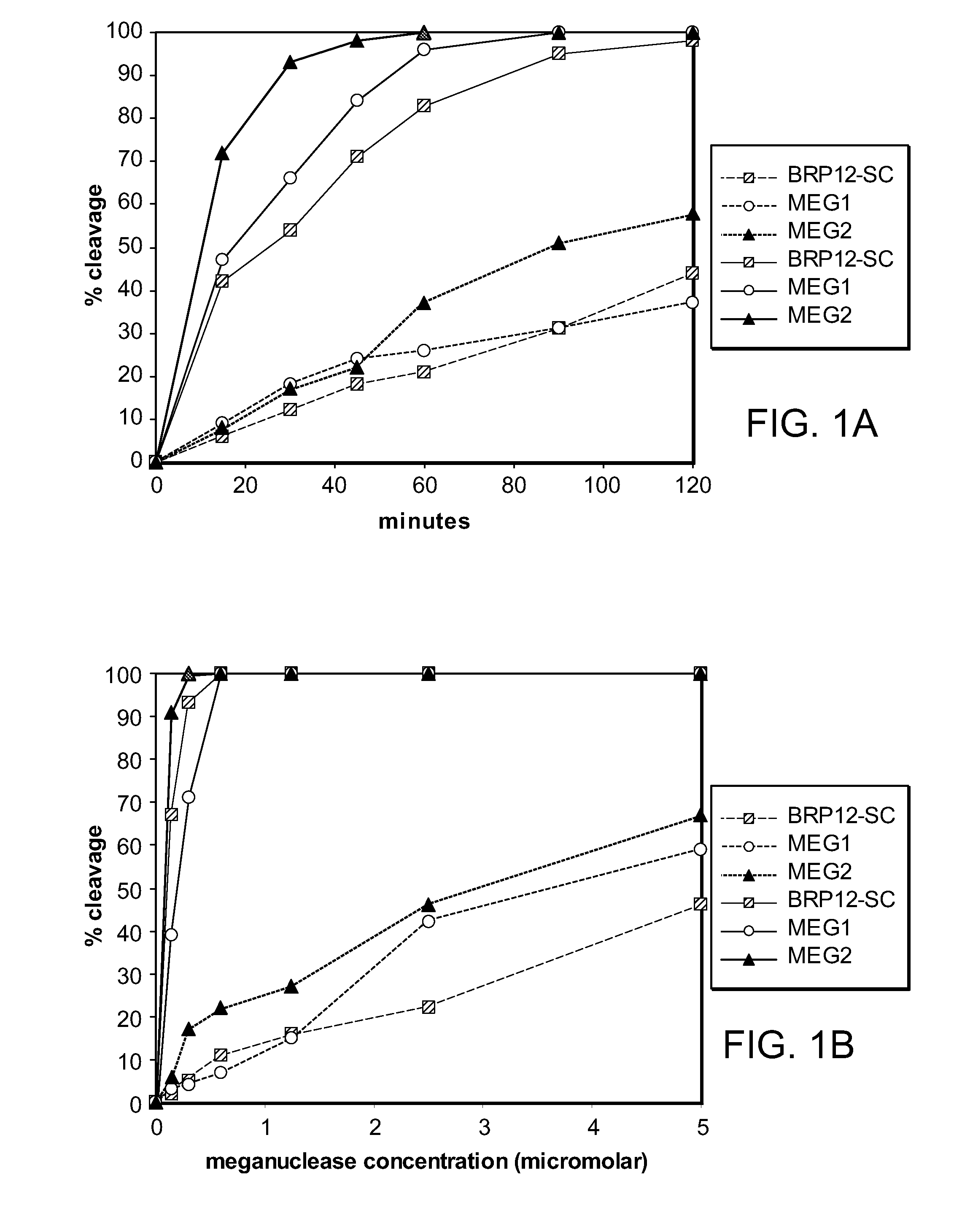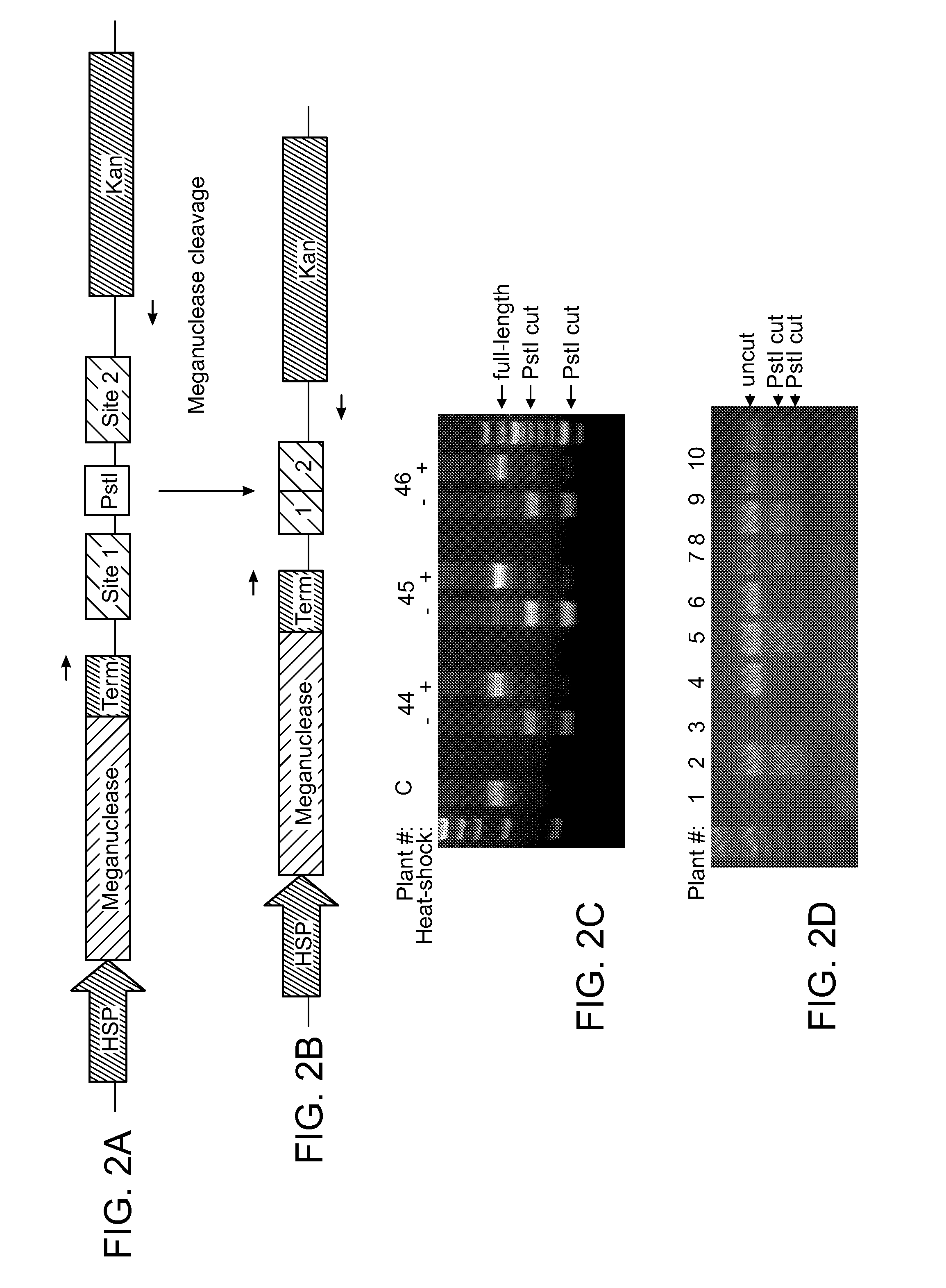Temperature-dependent meganuclease activity
a meganuclease and temperature-dependent technology, applied in the field ofmolecular biology and recombinant nucleic acid technology, can solve the problems of residual non-specific cleavage activity, high mutagenic and toxic, and inability to target gene modifications to unique sites within a chromosomal background
- Summary
- Abstract
- Description
- Claims
- Application Information
AI Technical Summary
Benefits of technology
Problems solved by technology
Method used
Image
Examples
example 1
[0077]Elevated Temperature Stimulates the Activity of an Engineered Meganuclease in a Plant
[0078]An engineered meganuclease called BRP2 (SEQ ID NO: 1) was produced using the method disclosed in WO 2007 / 047859. This meganuclease is derived from I-CreI and was engineered to recognize a DNA site that is not recognized by wild-type I-CreI (the BRP2 recognition sequence, SEQ ID NO: 3 and SEQ ID NO: 4). To facilitate nuclear localization of the engineered meganuclease, an SV40 nuclear localization signal (NLS, SEQ ID NO: 10) was added to the N-terminus of the protein. Conventional Agrobacterium-mediated transformation procedures were used to transform Arabidopsis thaliana with a T-DNA containing a codon-optimized BRP2 coding sequence (SEQ ID NO: 7). Expression of BRP2 meganuclease was under the control of a Hsp70 promoter and a NOS terminator. A pair of BRP2 recognition sequences were housed on the same T-DNA separated by 7 base pairs containing a PstI restriction enzyme site (FIG. 2a). B...
example 2
Marker Excision using a Heat-Stimulated Engineered Meganuclease
[0081]The experiment described in Example 1 was repeated with a T-DNA in which a basta resistance (BAR) gene was incorporated between the two BRP2 recognition sequences in place of the PstI site (FIG. 2a). In this experiment, BRP2 cleavage of the BRP2 recognition sequences flanking the BAR gene was expected to excise the BAR gene from the integrated T-DNA (FIG. 2b). PCR analysis of the T-DNA before and after a 2 hour heat-shock at 40° C. (as in Example 1) revealed that the BAR gene was efficiently excised from somatic leaf cell genomic DNA following the heat shock (FIG. 2c).
example 3
Heat-Stimulated Engineered Meganucleases Cleave a Native Site in a Plant Genome
[0082]The engineered meganuclease BRP12-SC (SEQ ID NO: 4) was produced in accordance with WO 2007 / 047859 except that this meganuclease is a single-chain heterodimer. As discussed in WO / 2007 / 047859, wild-type I-CreI binds to and cleaves DNA as a homodimer. As a consequence, the natural recognition sequence for I-CreI is pseudo-palindromic. The BRP12-SC recognition sequence (SEQ ID NO: 5, SEQ ID NO: 6), however, is non-palindromic. This necessitates the use of an engineered meganuclease heterodimer comprising a pair of subunits each of which recognizes one half-site within the full-length recognition sequence. In the case of BRP12-SC, the two engineered meganuclease monomers are physically linked to one another using an amino acid linker to produce a single-chain heterodimer. This linker comprises amino acids 166-204 (SEQ ID NO: 9) of BRP12-SC. The linker sequence joins an N-terminal meganuclease subunit te...
PUM
| Property | Measurement | Unit |
|---|---|---|
| temperature | aaaaa | aaaaa |
| temperature | aaaaa | aaaaa |
| temperature | aaaaa | aaaaa |
Abstract
Description
Claims
Application Information
 Login to View More
Login to View More - R&D
- Intellectual Property
- Life Sciences
- Materials
- Tech Scout
- Unparalleled Data Quality
- Higher Quality Content
- 60% Fewer Hallucinations
Browse by: Latest US Patents, China's latest patents, Technical Efficacy Thesaurus, Application Domain, Technology Topic, Popular Technical Reports.
© 2025 PatSnap. All rights reserved.Legal|Privacy policy|Modern Slavery Act Transparency Statement|Sitemap|About US| Contact US: help@patsnap.com



